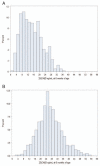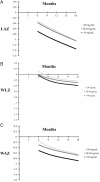Vitamin D Deficiency Is Not Associated With Growth or the Incidence of Common Morbidities Among Tanzanian Infants
- PMID: 28644368
- PMCID: PMC5604126
- DOI: 10.1097/MPG.0000000000001658
Vitamin D Deficiency Is Not Associated With Growth or the Incidence of Common Morbidities Among Tanzanian Infants
Abstract
Objective: The objective of this study was to examine risk factors for vitamin D deficiency and determine the association of vitamin D status with child growth and incidence of common morbidities among Tanzanian infants.
Methods: A prospective cohort of 581 Tanzanian infants born to human immunodeficiency virus (HIV)-uninfected mothers had serum 25-hydroxyvitamin D assessed at 6 weeks and 6 months of age. Infants were seen at monthly clinic visits for growth monitoring until 18 months of age. Physicians examined infants every 3 months or when an illness was noted to document morbidities.
Results: The prevalence of vitamin D deficiency (<20 ng/mL) declined from 76.4% at 6 weeks of age to 21.2% at 6 months. Infants who were exclusively breastfed at 6 weeks of age had 2.05 (95% confidence interval 1.11-3.79; P = 0.02) times the risk of vitamin D deficiency as compared formula-fed infants. After multivariate adjustment, there was no association of vitamin D status at 6 weeks or 6 months with the incidence of stunting, wasting, or underweight. There was also no association of low vitamin D with the incidence of diarrhea, upper respiratory infection, acute lower respiratory tract infection, or malaria.
Conclusions: Vitamin D deficiency is common during early infancy, particularly among exclusively breastfed infants; however, these observational data suggest it may not be an important contributor to morbidity and growth among the general population of Tanzanian infants. Future studies of vitamin D among high-risk infants, including those with low birthweight and exposed to HIV, may be warranted.
Conflict of interest statement
The authors report no conflicts of interest.
Figures



Comment in
-
Commentary to Article Entitled "Vitamin D Deficiency Is Not Associated With Growth or the Incidence of Common Morbidities Among Tanzanian Infants".J Pediatr Gastroenterol Nutr. 2017 Oct;65(4):357-358. doi: 10.1097/MPG.0000000000001702. J Pediatr Gastroenterol Nutr. 2017. PMID: 28753189 No abstract available.
Similar articles
-
Vitamin A supplements ameliorate the adverse effect of HIV-1, malaria, and diarrheal infections on child growth.Pediatrics. 2002 Jan;109(1):E6. doi: 10.1542/peds.109.1.e6. Pediatrics. 2002. PMID: 11773574 Clinical Trial.
-
Predictors of stunting, wasting and underweight among Tanzanian children born to HIV-infected women.Eur J Clin Nutr. 2012 Nov;66(11):1265-76. doi: 10.1038/ejcn.2012.136. Epub 2012 Oct 3. Eur J Clin Nutr. 2012. PMID: 23031850 Free PMC article. Clinical Trial.
-
High Burden of Morbidity and Mortality but Not Growth Failure in Infants Exposed to but Uninfected with Human Immunodeficiency Virus in Tanzania.J Pediatr. 2017 Jan;180:191-199.e2. doi: 10.1016/j.jpeds.2016.09.040. Epub 2016 Nov 7. J Pediatr. 2017. PMID: 27829511 Free PMC article.
-
Vitamin D deficiency in exclusively breast-fed infants.Indian J Med Res. 2008 Mar;127(3):250-5. Indian J Med Res. 2008. PMID: 18497439 Review.
-
Nutrition, growth, and allergic diseases among very preterm infants after hospital discharge.Dan Med J. 2013 Feb;60(2):B4588. Dan Med J. 2013. PMID: 23461996 Review.
Cited by
-
The relationship of vitamin D deficiency and childhood diarrhea: a systematic review and meta-analysis.BMC Pediatr. 2024 Feb 16;24(1):125. doi: 10.1186/s12887-024-04599-0. BMC Pediatr. 2024. PMID: 38365626 Free PMC article.
-
Vitamin D Status and Its Influence on the Health of Preschool Children in Hangzhou.Front Public Health. 2021 May 17;9:675403. doi: 10.3389/fpubh.2021.675403. eCollection 2021. Front Public Health. 2021. PMID: 34079788 Free PMC article.
-
Vitamin D in malaria: more hypotheses than clues.Heliyon. 2019 Feb 6;5(2):e01183. doi: 10.1016/j.heliyon.2019.e01183. eCollection 2019 Feb. Heliyon. 2019. PMID: 30793054 Free PMC article. Review.
-
Association Between Vitamin D Status and Undernutrition Indices in Children: A Systematic Review and Meta-Analysis of Observational Studies.Front Pediatr. 2021 Jun 4;9:665749. doi: 10.3389/fped.2021.665749. eCollection 2021. Front Pediatr. 2021. PMID: 34150687 Free PMC article.
-
Vitamin D status, nutrition and growth in HIV-infected mothers and HIV-exposed infants and children in Botswana.PLoS One. 2020 Aug 13;15(8):e0236510. doi: 10.1371/journal.pone.0236510. eCollection 2020. PLoS One. 2020. PMID: 32790765 Free PMC article.
References
-
- Holick MF. Vitamin D deficiency. N Engl J Med 2007; 357:266–281. - PubMed
-
- Lips P. Worldwide status of vitamin D nutrition. J Steroid Biochem Mol Biol 2010; 121:297–300. - PubMed
-
- Mithal A, Wahl DA, Bonjour JP, et al. Global vitamin D status and determinants of hypovitaminosis D. Osteoporos Int 2009; 20:1807–1820. - PubMed
-
- Greer FR, Marshall S. Bone mineral content, serum vitamin D metabolite concentrations, and ultraviolet B light exposure in infants fed human milk with and without vitamin D2 supplements. J Pediatr 1989; 114:204–212. - PubMed
-
- Wagner CL, Greer FR. Prevention of rickets and vitamin D deficiency in infants, children, and adolescents. Pediatrics 2008; 122:1142–1152. - PubMed
Publication types
MeSH terms
Grants and funding
LinkOut - more resources
Full Text Sources
Other Literature Sources
Medical

